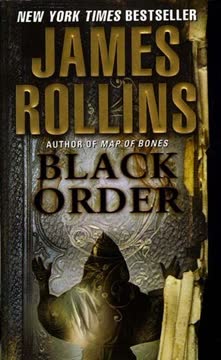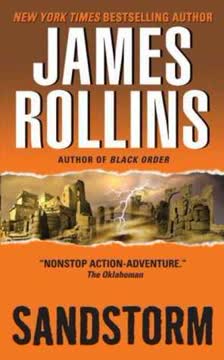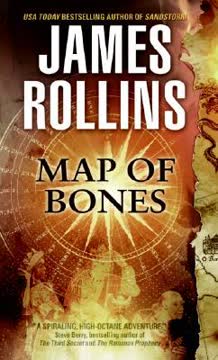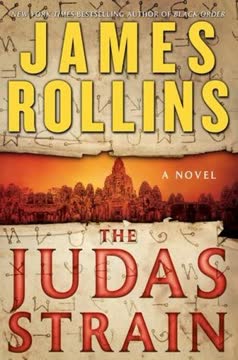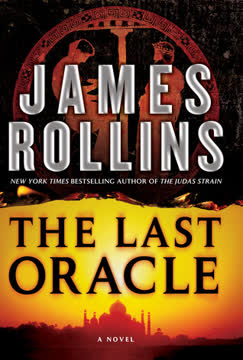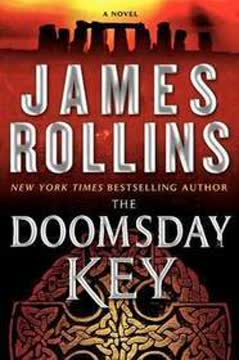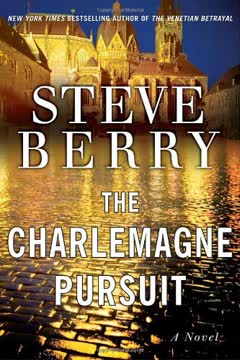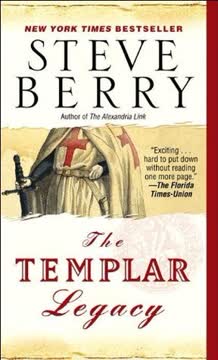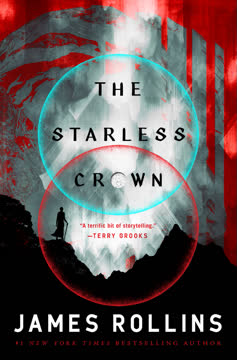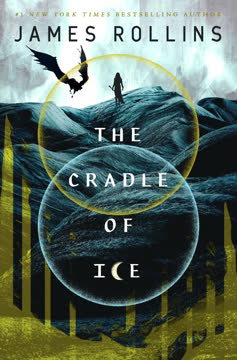Plot Summary
Nazi Shadows Resurface
In the dying days of World War II, Nazi scientists race to evacuate a mysterious device called the Bell (die Glocke) from a hidden research facility. Ruthless SS officers execute witnesses and scientists, but a single child—product of forbidden experiments—survives, spirited away into the chaos. Decades later, the legacy of these experiments and the Bell's disappearance cast a long shadow, as covert organizations and powerful families vie to control its secrets.
Ghost Lights in the Himalayas
In the present, Dr. Lisa Cummings, a mountaineer and physician, is summoned to a remote Himalayan monastery struck by a bizarre illness. Mysterious lights—"ghost lights"—have appeared in the mountains, and soon, madness and death sweep through the monks and livestock. Lisa, joined by Painter Crowe, a covert Sigma Force director, is swept into a nightmare as the monastery is attacked and burned by unknown assailants, forcing them to flee into the mountains.
Madness at the Monastery
Lisa and Painter discover the illness is not natural: it causes psychosis, self-mutilation, and death. The monastery is methodically destroyed to erase evidence, and survivors are hunted. Painter, suffering from the same symptoms, realizes the attack is part of a larger cover-up. The pair's only hope is to escape into the uncharted "no-man's-land" of the Himalayas, even as a storm and the threat of further attacks close in.
The Darwin Bible's Secret
In Copenhagen, Sigma agent Grayson Pierce investigates a surge of interest in Victorian scientific manuscripts, especially a Bible once owned by Charles Darwin. The book's provenance leads to a string of murders and arson, as assassins pursue Gray and a streetwise teen, Fiona. The Bible contains cryptic runes and a hidden code, linked to Nazi eugenics and the Bell project.
Assassins in Copenhagen
Gray and Fiona survive firebombs, snipers, and a harrowing escape through Tivoli Gardens, pursued by a family of white-blond, genetically engineered assassins. The trail leads to Germany, where the origins of the Darwin Bible and its coded message are tied to a Nazi scientist, Hugo Hirszfeld, and the infamous Wewelsburg Castle—Himmler's "Black Camelot."
The Black Sun Legacy
At Wewelsburg, Gray uncovers the Black Sun project: Nazi attempts to create a master race using quantum experiments and the Bell. The runes in the Bible are a code left by Hirszfeld, who regretted his role in the atrocities. Meanwhile, the Waalenberg family in South Africa, heirs to Nazi secrets, have built their own Bell and continued the experiments, creating a new generation of "superchildren" and monstrous chimeras.
Genetic Experiments Unleashed
The Waalenbergs' estate is a fortress, hiding a menagerie of genetically engineered beasts and children bred for perfection. Their patriarch, Baldric, plans to use the Bell's power to "cleanse" humanity, targeting enemies with a quantum weapon. Sigma agents, Zulu warriors, and British intelligence converge on the estate as the Waalenbergs unleash their creations to hunt down intruders.
The Bell's Deadly Power
The Bell, powered by the mysterious Xerum 525, can manipulate DNA at the quantum level—evolving or devolving life. Baldric plans to use it as a targeted weapon, erasing his enemies' genetic lines. As the estate descends into chaos, the Bell is activated, threatening to kill all who oppose the Waalenbergs and to unleash devastation far beyond South Africa.
The Waalenberg Menagerie
As Zulu forces storm the estate, Sigma agents and allies fight through packs of monstrous hyenas and genetically altered guards. Fiona, using a stolen control device, leads the beasts in a desperate counterattack. The battle rages through the mansion's halls and laboratories, with the fate of the Bell and the world hanging in the balance.
Quantum Evolution Unveiled
Anna Sporrenberg, last of the Nazi scientists, explains the Bell's function: it is a quantum-measuring device, capable of directing evolution or causing catastrophic devolution. The secret to controlling it lies in the code left by Hirszfeld—a jigsaw of runes forming the Star of David, symbolizing the union of body and soul, matter and consciousness.
Siege of the Golden Bell
As the Bell's pulse builds, Gray and Lisa race to decipher the code and stop Baldric's genocidal plan. Anna sacrifices herself to neutralize the Bell, while Baldric is consumed by his own creation, devolved into a monstrous form. The estate is destroyed in a quantum explosion, erasing the Waalenberg legacy and their menagerie.
The Code of Perfection
The runic code is not a cipher, but a puzzle: the Star of David, representing the quantum link between consciousness and reality. Hugo's final experiment succeeded because he entered the Bell chamber with faith, prayer, and focused intent—his consciousness "measured" the quantum potential, collapsing it into perfection. Lisa uses this insight to save Painter, focusing her will and love to heal him in the Bell's field.
Sacrifice and Salvation
Anna and Gunther, last of the Nazi line, are lost—one to sacrifice, one to grief. The Waalenberg family is eradicated, their monstrous legacy ended. Sigma agents and their allies survive, but not without scars. The world is saved from a new age of eugenic tyranny, but the cost is high: friends lost, innocence shattered, and the future forever changed.
The End of the Black Order
Investigations reveal the Waalenbergs' true origins: their "superchildren" are the result of Himmler's preserved genetic material, not Baldric's own. The Black Sun project, born of Nazi occult science and quantum ambition, is finally destroyed. Survivors reflect on the dangers of unchecked science and the seductive lure of perfection.
Ripples of Faith and Science
The novel closes with meditations on quantum evolution, the role of consciousness in shaping reality, and the interplay of faith and science. The Star of David, the Bell, and the runes become symbols of humanity's potential—and its peril—when wielding the power to shape life itself.
New Beginnings, Old Questions
Painter recovers, Lisa at his side. Monk and Kat, wounded but alive, look forward to a new family. Fiona finds a home and a future. Gray, haunted by the past, faces his own fears about love and fatherhood, realizing that the future is not fixed, but shaped by choice, will, and belief.
Characters
Painter Crowe
Painter is the director of Sigma Force, a covert DARPA team. A man of mixed Native American heritage, he is both a scientist and a warrior, driven by a sense of duty and a need to atone for past failures. Painter's journey is both physical and existential: afflicted by the Bell's quantum disease, he faces his mortality and the limits of science. His relationship with Lisa Cummings becomes a source of vulnerability and strength, culminating in a leap of faith that saves his life. Painter's arc is one of self-acceptance, humility, and the recognition that true power lies in the union of mind, body, and spirit.
Lisa Cummings
Lisa is a physician and mountaineer, fiercely independent yet emotionally guarded. Her scientific skepticism is challenged by the Bell's mysteries and the horrors she witnesses. Through trauma and loss, Lisa learns to trust not only her intellect but her heart, ultimately using focused will and love to heal Painter. Her development reflects the novel's central theme: the necessity of integrating reason and belief, science and faith, to confront the unknown.
Grayson Pierce
Gray is a Sigma agent, skilled and resourceful but emotionally scarred by a difficult relationship with his father. His investigation into the Darwin Bible and Nazi secrets forces him to confront questions of identity, responsibility, and the fear of repeating his father's mistakes. Gray's bond with Fiona reveals his capacity for mentorship and compassion, while his struggle with commitment to Rachel Verona mirrors his internal conflict between potential and reality.
Fiona
Fiona is a teenage orphan, sharp-tongued and resourceful, whose life on the streets of Europe has made her both tough and vulnerable. Her involvement in the conspiracy is accidental, but she proves indispensable, outwitting assassins and helping to decode the Bell's secret. Fiona's journey is one of trust and self-worth, finding family and purpose among the Sigma team.
Monk Kokkalis
Monk is a Sigma agent, physically and emotionally scarred by past missions. His prosthetic hand is both a symbol of loss and a tool of ingenuity. Monk's relationship with Kat Bryant, and the prospect of fatherhood, force him to confront vulnerability and hope. His humor and steadfastness provide balance to the team's darker moments.
Kat Bryant
Kat is a Sigma agent and Monk's partner, both professionally and personally. Her pregnancy and near-fatal injuries in Washington, D.C., highlight the risks and sacrifices of their work. Kat's analytical mind and emotional resilience make her a linchpin in the Sigma network, even as she grapples with the uncertainties of love and life.
Anna Sporrenberg
Anna is the last of the Nazi scientists at Granitschloft, burdened by her family's legacy and her own complicity. Brilliant but emotionally scarred, she is both a victim and perpetrator of the Bell's horrors. Anna's final act is one of sacrifice, using her knowledge to save others and atone for the sins of the past.
Gunther
Gunther is Anna's brother, the last of the Sonnekonige—genetically engineered "Knights of the Sun." Immune to the Bell's disease but doomed to degeneration, he is shunned as a "leper king." Gunther's strength and loyalty are matched by his grief and isolation, culminating in a final act of protection for his sister.
Baldric Waalenberg
Baldric is the reclusive head of the Waalenberg family, obsessed with genetic perfection and the resurrection of the Aryan race. His cold rationality and scientific brilliance are twisted by a lack of empathy, leading to monstrous experiments and the creation of a new Black Order. Baldric's downfall is poetic justice: consumed by the very forces he sought to control.
Isaak and Ischke Waalenberg
The white-blond, tattooed twins are Baldric's grandchildren and enforcers, products of generations of genetic manipulation. Their preternatural abilities and lack of empathy make them deadly adversaries. Their incestuous bond and ultimate demise reflect the self-destructive nature of the quest for purity and control.
Plot Devices
Dual Timelines and Historical Echoes
The novel weaves together WWII-era Nazi science and present-day covert operations, using flashbacks, historical documents, and coded messages to reveal the continuity of evil. The sins of the fathers—literal and metaphorical—reverberate through generations, forcing characters to confront inherited guilt and the possibility of redemption.
The Bell as MacGuffin and Symbol
The Bell is both a literal quantum machine and a metaphor for humanity's drive to control evolution. Its power to evolve or devolve life, depending on the will and consciousness of the observer, makes it the ultimate weapon—and the ultimate test of character. The Bell's activation is the novel's central crisis, with its outcome determined not by technology alone, but by faith, intent, and sacrifice.
Codes, Runes, and Jigsaw Puzzles
The runic code in the Darwin Bible is a classic puzzle, requiring not just cryptographic skill but emotional insight. The solution—a Star of David formed from runes—embodies the union of science and spirituality, body and soul. The act of solving the puzzle mirrors the characters' journeys toward integration and wholeness.
Quantum Evolution and Intelligent Design
The novel explores cutting-edge ideas in quantum biology, consciousness, and evolution, blurring the line between science and faith. The Bell's function as a quantum-measuring device literalizes the debate over intelligent design, suggesting that consciousness—and perhaps prayer—can shape reality at the most fundamental level.
Sacrifice and Redemption
Characters are forced to make choices that test their values: Anna's self-sacrifice, Lisa's leap of faith, Gray's willingness to risk everything for Fiona. The theme of redemption—atoning for past sins, breaking cycles of violence, and choosing hope over despair—runs throughout, culminating in acts of courage that save not just individuals, but the future of humanity.
Analysis
Black Order is a high-octane fusion of historical thriller, science fiction, and philosophical inquiry, using the legacy of Nazi occult science as a lens to examine humanity's perennial quest for perfection—and the dangers that quest entails. The novel's central conceit, that consciousness and will can shape evolution at the quantum level, is both a metaphor for personal growth and a literal plot device, raising questions about the limits of science, the role of faith, and the meaning of free will. Rollins warns against the seductive allure of control—whether through eugenics, technology, or ideology—while celebrating the messy, unpredictable, and redemptive power of love, sacrifice, and belief. The story's resolution, in which faith and science are reconciled through the act of healing, suggests that the future is not predetermined by the past, but is shaped by the choices we make, individually and collectively. In a world haunted by the shadows of history, Black Order offers a vision of hope: that even in the face of monstrous ambition, humanity can choose compassion, humility, and the courage to embrace the unknown.
Last updated:
FAQ
Synopsis & Basic Details
What is Black Order about?
- Nazi Legacy Unveiled: Black Order by James Rollins plunges readers into a global conspiracy rooted in a secret Nazi project from World War II, involving a mysterious device called "the Bell" (die Glocke) capable of manipulating life at a quantum level. The story follows Sigma Force agents as they uncover a hidden network of descendants and powerful families, like the Waalenbergs, who seek to harness this technology for their own vision of human evolution and global control.
- Race Against Devolution: The narrative intertwines multiple plotlines: Dr. Lisa Cummings and Sigma Director Painter Crowe battling a deadly, mind-altering illness in the Himalayas caused by the Bell's radiation, while Commander Grayson Pierce investigates a series of murders and a coded Darwin Bible in Europe, all connected to the same sinister organization. The core conflict revolves around stopping the Waalenbergs from unleashing a quantum weapon that could "cleanse" humanity according to their eugenic ideals.
- Science, Faith, and Survival: Beyond the action, the novel delves into profound themes of quantum evolution, intelligent design, and the power of human consciousness. Characters grapple with the ethical implications of unchecked scientific ambition, the weight of historical atrocities, and the redemptive power of sacrifice, love, and belief in the face of seemingly insurmountable odds.
Why should I read Black Order?
- Thrilling Blend of History & Sci-Fi: Black Order offers a unique fusion of historical intrigue, drawing on real-world Nazi occult research and scientific theories, with cutting-edge science fiction concepts like quantum evolution. Readers who enjoy fast-paced action, global conspiracies, and intellectual puzzles will find this novel deeply engaging.
- Deep Dive into Ethical Dilemmas: The book doesn't shy away from complex moral questions, exploring the dangers of eugenics, the allure of perfection, and the ethical responsibilities of scientific discovery. It challenges readers to consider the fine line between progress and perversion, making it a thought-provoking read beyond its thrilling plot.
- Rich Character Arcs & Emotional Depth: Despite the high-stakes action, Black Order features compelling character development. From Painter Crowe's struggle with a debilitating illness and his quest for redemption, to Gray Pierce's personal journey confronting his past, and Lisa Cummings's evolution from skeptic to believer, the characters' emotional journeys add significant depth to the narrative.
What is the background of Black Order?
- WWII Nazi Occultism & Secret Science: The novel is heavily grounded in the historical reality of Nazi Germany's fascination with the occult, particularly Heinrich Himmler's belief in an Aryan master race and his expeditions to the Himalayas. It draws on documented "deep black projects" like Operation Paperclip and the real-life mystery of "die Glocke" (the Bell), a purported Nazi wonder weapon. This historical context provides a chilling foundation for the fictional quantum experiments.
- Cutting-Edge Quantum Physics & Biology: James Rollins integrates actual scientific theories, such as quantum mechanics, zero-point energy, and the debate around intelligent design versus Darwinian evolution. The concept of "quantum evolution," where consciousness can influence genetic mutation, is central to the plot, blurring the lines between established science and speculative fiction.
- Global Geopolitical Landscape: The story spans diverse geographical and political landscapes, from the besieged city of Breslau in 1945 to modern-day Copenhagen, the remote Himalayas, and the post-apartheid wilderness of South Africa. This global backdrop highlights the far-reaching influence of the conspiracy and the diverse cultural and historical forces at play.
What are the most memorable quotes in Black Order?
- "It defies God and nature.": Spoken by Tola Hirszfeld in 1945, this quote encapsulates the core ethical conflict of the novel, highlighting the inherent blasphemy and danger of the Nazi's genetic experiments with the Bell. It foreshadows the monstrous outcomes of tampering with life's fundamental processes, a theme that resonates throughout the entire Black Order narrative.
- "Oftentimes, it is madness more than genius that moves the world forward. Who else but the mad would reach so far, stretching for the impossible? And in so doing, prove the impossible possible.": Anna Sporrenberg's chilling reflection on the nature of scientific ambition reveals the dangerous philosophy driving the Black Sun project. This quote, central to understanding the themes in Black Order, suggests that the pursuit of perfection, when unconstrained by ethics, can lead to both groundbreaking discoveries and horrific atrocities.
- "Prayer works.": Lisa Cummings's profound realization at the climax, after Gray deciphers Hugo's code, signifies the novel's ultimate reconciliation of science and faith. This quote, pivotal to the Black Order ending explained, asserts that human consciousness, focused through belief and intent, can directly influence reality at the quantum level, offering a powerful counterpoint to the cold, mechanistic view of genetic manipulation.
What writing style, narrative choices, and literary techniques does James Rollins use?
- Propulsive, Action-Oriented Prose: Rollins employs a fast-paced, direct writing style, characterized by short sentences and paragraphs that maintain high tension and propel the plot forward. His narrative is often visceral, with vivid descriptions of action sequences, scientific phenomena, and grotesque mutations, keeping readers on the edge of their seats.
- Alternating Perspectives and Global Scope: The novel utilizes a multi-POV structure, shifting between different characters (Painter, Gray, Lisa, Monk) and diverse global locations. This narrative choice creates a sense of a vast, interconnected conspiracy, allowing Rollins to build suspense and reveal pieces of the puzzle from various angles, enriching the Black Order analysis.
- Integration of Real-World Science and History: A hallmark of Rollins's style is his meticulous research into scientific theories and historical events, which he then seamlessly weaves into his fictional narrative. This technique lends a veneer of plausibility to even the most fantastical elements, making the themes in Black Order feel grounded and thought-provoking, often blurring the lines between truth and fiction.
Hidden Details & Subtle Connections
What are some minor details that add significant meaning?
- Fiona's "Hope" Bracelet: Early in the novel, Fiona is described wearing a white rubber bracelet with "hope" stamped on it. This seemingly minor detail subtly foreshadows her eventual role as a beacon of hope and resilience in the face of overwhelming darkness, contrasting with the despair and nihilism of the Waalenbergs. It also highlights her inherent goodness despite her street-hardened exterior, a key aspect of her character development.
- The Waalenberg Crest's Hidden Swastika: Gray's discovery that the Waalenberg family crest, a Celtic shield knot, can be "tightened" to reveal a hidden swastika is a crucial, yet easily missed, visual clue. This detail not only confirms the family's deep Nazi ties but also symbolizes how insidious and camouflaged evil can be, hiding in plain sight behind seemingly innocuous symbols. It's a powerful piece of symbolism in Black Order.
- Painter's Missing Fingernail: As Painter's quantum disease progresses, he notices his fingernail has been "ripped away," leaving pale, dry flesh. This detail, initially attributed to an injury, is later revealed to be a symptom of the devolution, mirroring Anna's description of the Sonnekonige's necrosis. It's a subtle, chilling indicator of the disease's advanced stage and Painter's impending fate, adding a visceral layer to his character motivations and the urgency of finding a cure.
What are some subtle foreshadowing and callbacks?
- Jakob Sporrenberg's Revulsion to the Jewish Infant: In the 1945 prologue, SS Obergruppenfuhrer Jakob Sporrenberg expresses profound revulsion that "all of the hopes for the Third Reich lay in his tiny hands—the hands of a Jewish infant." This deeply ironic detail subtly foreshadows the ultimate twist: that Himmler's own genetic material, intended for the Aryan master race, was unknowingly preserved and used by Baldric Waalenberg, making the "perfect" Sonnekonige descendants of the very people the Nazis sought to exterminate. It's a powerful callback to the historical context and a key element of the Black Order ending explained.
- Monk's Prosthetic Hand as a Weapon: Monk's state-of-the-art DARPA prosthetic hand is initially presented as a symbol of his past trauma and resilience. However, the detail that it contains a hidden flash charge, capable of being detonated wirelessly, is subtly foreshadowed by Gray's internal thought that "plastic and metal were not flesh" and Monk's later comment about Fiona not stealing "that, too." This callback to its technological capabilities allows for a crucial, unexpected distraction during their escape from the Waalenberg estate, highlighting the ingenuity of Sigma's tech and Monk's resourcefulness.
- The "Ghost Lights" and the Bell's Energy Venting: The Himalayan villagers' reports of "ghost lights" appearing in the mountains, which Painter initially dismisses as local superstition, are later revealed to be the visible manifestation of the Bell's excess energy being vented. This subtle foreshadowing connects the seemingly disparate elements of local folklore and advanced quantum physics, illustrating how the Bell's power impacts the environment and hinting at its true nature as a source of both illness and potential, a crucial piece of the Black Order analysis.
What are some unexpected character connections?
- Fiona's Unspoken Bond with Grette Neal: While Grette is Fiona's foster grandmother, the depth of their bond is subtly revealed through Fiona's intense grief and her fierce determination to avenge Grette's murder. Fiona's confession about Grette taking her in after she tried to steal from the shop, and Grette's consistent kindness, highlights a profound, almost maternal connection that transcends blood ties. This unexpected emotional depth in Fiona's character development underscores the novel's theme of chosen family and redemption.
- Gunther's Loyalty to Anna: The revelation that Gunther, the hulking, seemingly emotionless Sonnekonige assassin, is Anna Sporrenberg's brother adds a tragic layer to his character. His unwavering loyalty and willingness to sacrifice himself for Anna, despite his own debilitating condition and the disdain he faces from others, transforms him from a brute into a figure of profound, if misguided, familial love. This connection provides a powerful emotional counterpoint to the cold scientific ambition of the Waalenbergs, deepening the character motivations of both siblings.
- Father Piotr's Connection to the "Perfect Child": The epilogue reveals that Father Piotr, the kind priest Gray interviews, is the "perfect child" rescued by Father Varick in 1945—the very infant exposed to the Bell and prayed over by Hugo Hirszfeld. This unexpected connection subtly suggests that the Bell's influence, combined with focused human consciousness (prayer), resulted not in a superhuman, but in a man of profound goodness and resilience. It redefines "perfection" within the themes in Black Order, shifting it from genetic superiority to moral character.
Who are the most significant supporting characters?
- Dr. Marcia Fairfield: A British biologist and MI5 operative, Marcia is crucial for her deep knowledge of the African wilderness and her long-standing surveillance of the Waalenberg estate. Her personal loss (her partner's murder by the Waalenbergs) fuels her determination, and her scientific expertise proves invaluable in understanding the Waalenbergs' genetic experiments and the Bell's effects. Her resilience and intelligence make her a vital ally in the fight against the Black Order.
- Khamisi Taylor: The Zulu game warden, initially suspended for "cowardice," becomes a pivotal figure in rallying the local tribes against the Waalenbergs. His intimate knowledge of the terrain, his tracking skills, and his deep connection to his people provide the ground forces necessary for the assault on the estate. Khamisi's journey is one of reclaiming his honor and fighting for his community, embodying the spirit of resistance against colonial and scientific oppression.
- Ryan Hirszfeld: The grandson of Hugo Hirszfeld, Ryan's personal quest to understand his family's Nazi past provides critical historical context and leads Gray to the Wewelsburg Castle. His discovery of Hugo's cryptic letter and his willingness to share his findings, despite his father's reluctance, directly contributes to deciphering the Bell's secret. Ryan represents the younger generation grappling with inherited historical trauma and seeking truth.
Psychological, Emotional, & Relational Analysis
What are some unspoken motivations of the characters?
- Painter Crowe's Quest for Absolution: Beyond his duty as Sigma Director, Painter's personal journey is driven by an unspoken need for absolution, stemming from his past failures and the guilt of "passing the buck" on Ang Gelu's initial plea for help. His willingness to face the quantum disease head-on and his fierce protectiveness of Lisa are subtle manifestations of this desire to atone and prove his worth, a deep-seated Painter Crowe motivation.
- Anna Sporrenberg's Desire for Legacy and Redemption: While outwardly driven by scientific ambition and a twisted sense of duty to her Nazi heritage, Anna's deeper, unspoken motivation is a desperate yearning for her family's legacy to be redeemed, not just preserved. Her sacrifice, and her final declaration "I'm not a Nazi," suggest a profound internal conflict and a desire for absolution for the sins of her ancestors and her own complicity, making her a complex figure in Black Order analysis.
- Baldric Waalenberg's Fear of Irrelevance: Baldric's relentless pursuit of genetic perfection and his desire to "cleanse" humanity are fueled by an unspoken, profound fear of his own sterility and the end of his family line. His obsession with breeding and control is a desperate attempt to overcome his personal biological failure and ensure his legacy, even if it means monstrous acts. This deep-seated insecurity drives much of his cruelty and ambition, a key aspect of Baldric Waalenberg's motivations.
What psychological complexities do the characters exhibit?
- Gray Pierce's Inherited Trauma and Fear of Fatherhood: Gray's difficult relationship with his father and his fear of repeating past mistakes create a significant psychological complexity. His initial reluctance to commit to Rachel and his panic at the thought of Monk's pregnancy reveal a deep-seated anxiety about his own capacity for fatherhood and the potential for inherited flaws. His journey forces him to confront these fears, culminating in a conscious choice to break the cycle, a central part of Grayson Pierce's character development.
- Lisa Cummings's Battle Between Rationality and Emotion: Lisa, a scientist and doctor, initially approaches the horrors with clinical detachment, a coping mechanism against the overwhelming trauma. However, her growing emotional attachment to Painter and her eventual "leap of faith" to save him reveal a profound psychological shift. She grapples with the limits of pure rationality, learning to embrace intuition, love, and belief as valid forces, showcasing her complex emotional turning points.
- Fiona's Resilience and Vulnerability: Fiona's streetwise exterior hides deep emotional scars from her past trauma and the loss of her foster grandmother. Her sharp tongue and defiant attitude are coping mechanisms, but her moments of raw grief and her desperate need for belonging reveal her underlying vulnerability. Her ability to form new bonds and her fierce loyalty to those she trusts highlight a complex interplay of toughness and tenderness, making her a compelling character in Black Order analysis.
What are the major emotional turning points?
- Painter's Acceptance of His Mortality: A critical emotional turning point for Painter occurs when Anna Sporrenberg clinically informs him he will "die in another three days. Most horribly." This stark confrontation with his own mortality, and the subsequent realization of his "devolution," forces him to shed his scientific detachment and embrace a more desperate, human fight for survival, deepening his bond with Lisa. This moment is crucial for understanding Painter Crowe's motivations.
- Fiona's Decision to Trust Gray: After Grette's murder and their harrowing escape, Fiona's initial anger and self-reliance give way to a desperate plea for Gray's help, culminating in her confession of "I have no one now." Gray's promise, "You have me," and his subsequent decision to take her with him, marks a significant emotional turning point for Fiona, allowing her to begin to heal and find a sense of belonging. This is a key moment in Fiona's character development.
- Lisa's Act of Love and Belief: The climax, where Lisa, despite her scientific skepticism, chooses to enter the Bell chamber with Painter and focuses her "prayer" and "belief" to heal him, is the ultimate emotional turning point. This act transcends her rational training, demonstrating her profound love for Painter and her acceptance of a quantum reality where consciousness can shape outcomes. It's a powerful resolution to her internal conflict between science and faith, central to the themes in Black Order.
How do relationship dynamics evolve?
- Painter and Lisa: From Professional Allies to Deeply Connected Partners: Their relationship evolves from a professional alliance born of necessity in the Himalayas to a profound emotional and spiritual bond. Initially, Lisa is Painter's doctor, and he is her enigmatic patient. As they face shared trauma and Painter's impending death, their connection deepens, culminating in Lisa's act of love that saves him. Their relationship becomes a central example of the novel's theme of integrating science and faith, showcasing evolving relationship dynamics.
- Gray and Fiona: From Reluctant Guardian to Chosen Family: Gray initially views Fiona as a nuisance and a responsibility he wants to shed. Fiona, in turn, is wary and manipulative. However, through shared danger and Gray's repeated acts of protection, their relationship transforms into a surrogate father-daughter bond. Fiona's loyalty and Gray's growing compassion for her highlight the theme of finding family in unexpected places, a significant aspect of Grayson Pierce's character development.
- Monk and Kat: Confronting Vulnerability and Embracing Parenthood: Monk and Kat's relationship, already established as loving but guarded, is tested by Kat's unexpected pregnancy and near-fatal injury. Monk's initial fear of commitment and Kat's anxieties about balancing career and family are brought to the forefront. Their journey forces them to confront their vulnerabilities and embrace the future, culminating in their engagement and a shared commitment to their new family, illustrating evolving relationship dynamics under extreme pressure.
Interpretation & Debate
Which parts of the story remain ambiguous or open-ended?
- The Full Extent of the Bell's Capabilities: While the novel explains the Bell as a quantum-measuring device capable of influencing evolution, the full scope of its potential remains somewhat ambiguous. Could it truly create a "perfect" human, or is that an unattainable ideal? The story hints at vast, unexplored possibilities, leaving readers to ponder the ultimate power and peril of such a device, a key aspect of Black Order analysis.
- Gunther's Ultimate Fate and Future Role: After Anna's sacrifice, Gunther, the last of the Sonnekonige, vanishes with her body, choosing to mourn alone. His future remains open-ended: will he seek revenge, find a new purpose, or simply succumb to his chronic degeneration? His unique immunity and tragic loyalty leave his character arc unresolved, inviting speculation about his potential return or a solitary end. This ambiguity adds depth to his character motivations.
- The Long-Term Effects of Quantum Evolution on Father Piotr: The epilogue reveals Father Piotr as the "perfect child" from Hugo's experiment, now a kind and healthy priest. However, the novel doesn't fully explore the long-term implications of his unique origin. Is his "perfection" purely physical, or does it extend to his spiritual well-being? The subtle hint that he, like Hugo, enjoys jigsaw puzzles, raises questions about inherited traits and the lasting, subtle influence of the Bell, leaving his story with a touch of mystery.
What are some debatable, controversial scenes or moments in Black Order?
- Anna Sporrenberg's Justification of "Mercy Killings": Anna's assertion that the slaughter of the monks at the monastery was an act of "mercy" due to their impending madness is a highly controversial moment. While presented from her perspective as a pragmatic choice to prevent horrific suffering, it forces readers to confront the ethical tightrope walked by characters operating under extreme circumstances, echoing historical justifications for atrocities. This scene sparks debate on the nature of compassion versus control, a central theme in Black Order.
- Baldric Waalenberg's Chimera Experiments and Inbreeding: The revelation of Baldric's grotesque experiments, breeding monstrous hyenas with human stem cells and then implanting hyena cells back into his own children, is deeply disturbing. This controversial aspect pushes the boundaries of genetic manipulation and eugenics, highlighting the depravity of unchecked scientific ambition and the perversion of family lineage. It's a moment designed to shock and provoke strong reactions, emphasizing the novel's warning against playing God.
- Lisa's Use of "Prayer" to Heal Painter: The climax, where Lisa, a scientist, consciously uses "prayer" and focuse
Review Summary
Black Order receives largely positive reviews, with readers praising its blend of science, history, and thrilling action. Many appreciate the exploration of quantum mechanics, evolution, and Nazi experiments. The Sigma Force characters are well-developed and engaging. Some find the book too long or far-fetched, but most enjoy the fast-paced plot and scientific elements. Readers often mention learning new information while being entertained. The novel is seen as a strong entry in the Sigma Force series, with many eager to continue reading Rollins' work.
Sigma Force Series
Download PDF
Download EPUB
.epub digital book format is ideal for reading ebooks on phones, tablets, and e-readers.
